Health and Social Inequalities Experienced by Deaf People in the UK
VerifiedAdded on 2020/05/28
|24
|7076
|131
Essay
AI Summary
This essay provides a comprehensive analysis of the health and social inequalities experienced by individuals with hearing disabilities in the United Kingdom. It explores the challenges faced by the deaf community, including barriers to accessing healthcare services, communication difficulties with healthcare professionals, and instances of discrimination in various aspects of life, such as employment and education. The essay examines the impact of these inequalities on health outcomes, health information access, and overall quality of life. It discusses the medical and social models of deafness, highlighting the importance of adopting a social model that addresses societal barriers and promotes inclusivity. Furthermore, the essay touches upon government initiatives and policies aimed at supporting the deaf community. The essay concludes by summarizing the strengths and grievances of the deaf community and offering recommendations for future actions to address these inequalities and improve the lives of people with hearing disabilities.
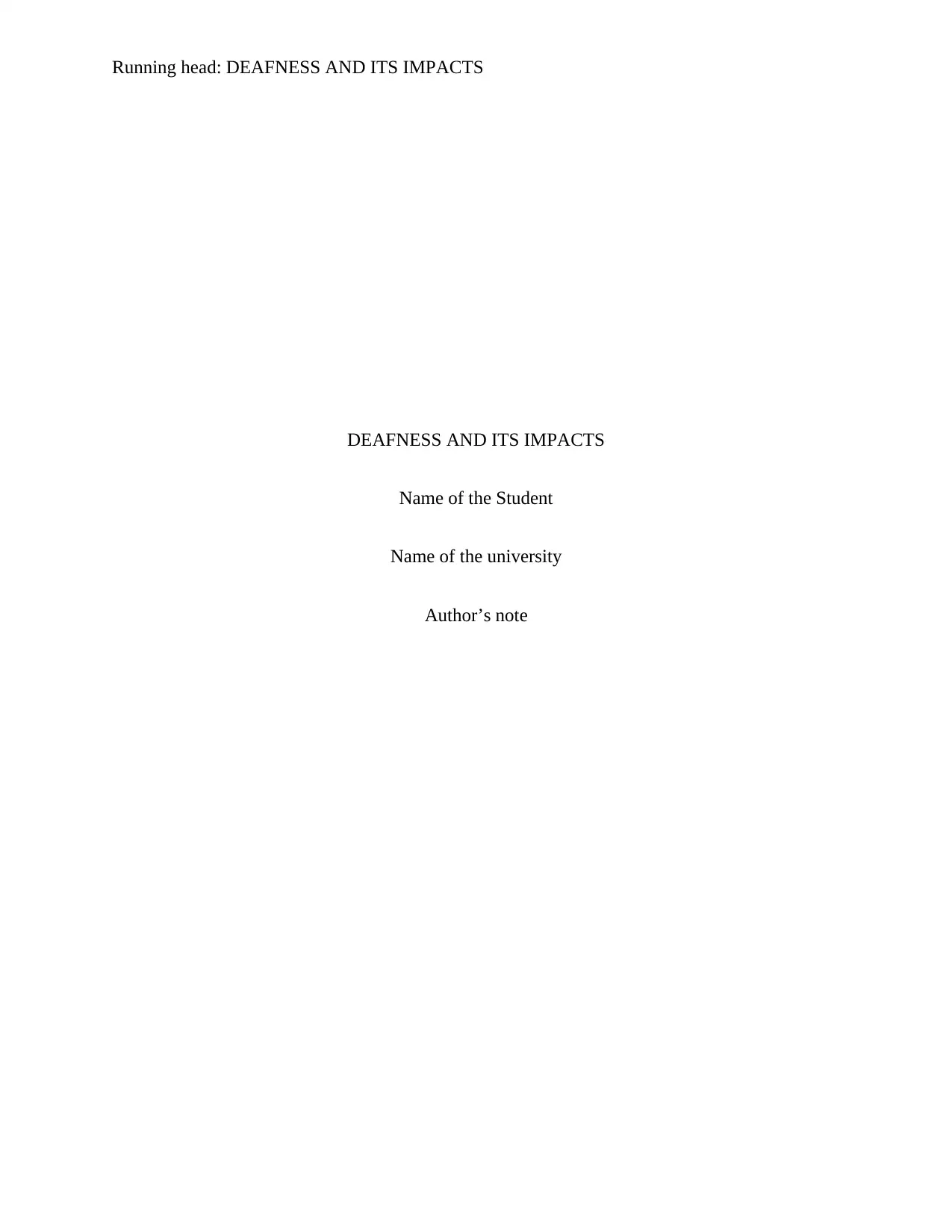
Running head: DEAFNESS AND ITS IMPACTS
DEAFNESS AND ITS IMPACTS
Name of the Student
Name of the university
Author’s note
DEAFNESS AND ITS IMPACTS
Name of the Student
Name of the university
Author’s note
Paraphrase This Document
Need a fresh take? Get an instant paraphrase of this document with our AI Paraphraser
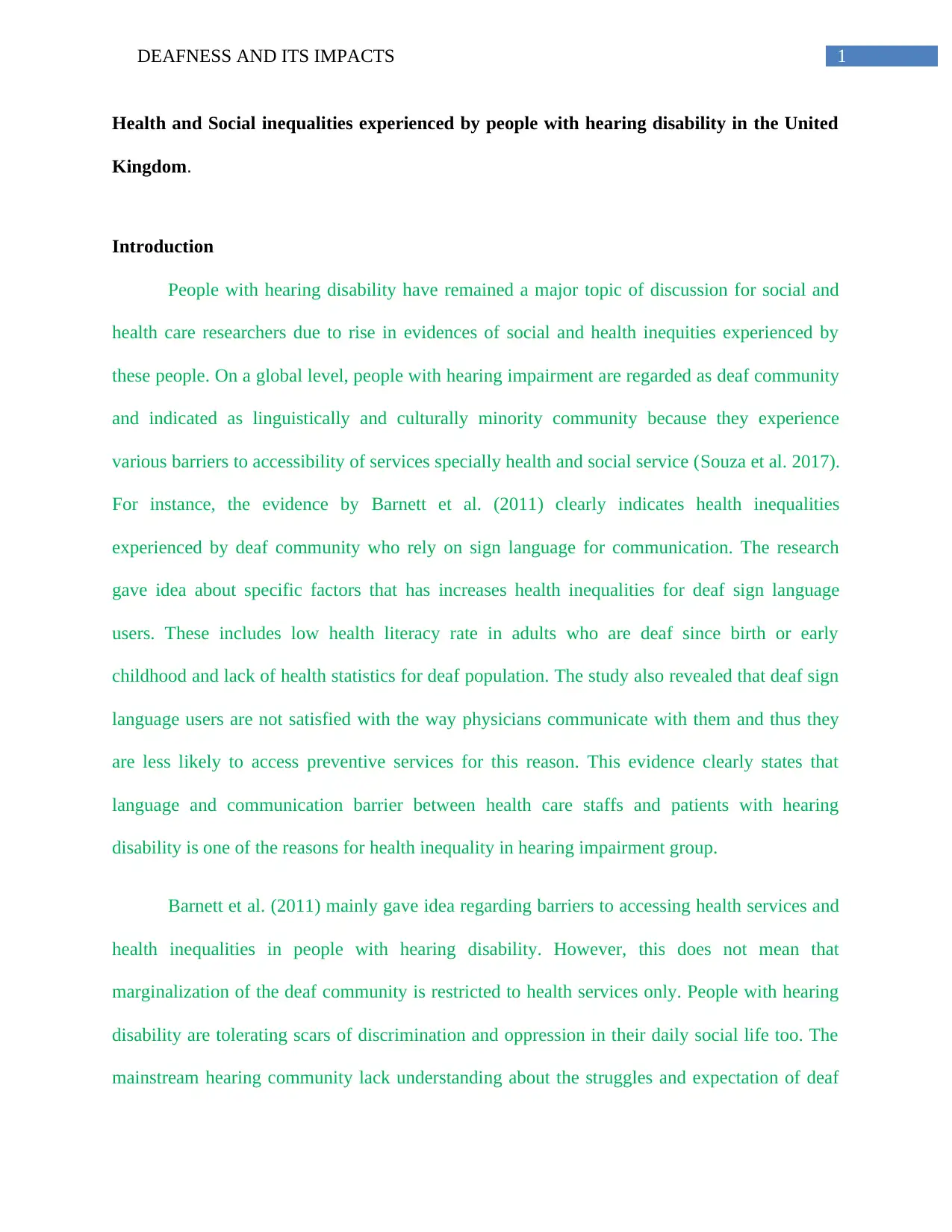
1DEAFNESS AND ITS IMPACTS
Health and Social inequalities experienced by people with hearing disability in the United
Kingdom.
Introduction
People with hearing disability have remained a major topic of discussion for social and
health care researchers due to rise in evidences of social and health inequities experienced by
these people. On a global level, people with hearing impairment are regarded as deaf community
and indicated as linguistically and culturally minority community because they experience
various barriers to accessibility of services specially health and social service (Souza et al. 2017).
For instance, the evidence by Barnett et al. (2011) clearly indicates health inequalities
experienced by deaf community who rely on sign language for communication. The research
gave idea about specific factors that has increases health inequalities for deaf sign language
users. These includes low health literacy rate in adults who are deaf since birth or early
childhood and lack of health statistics for deaf population. The study also revealed that deaf sign
language users are not satisfied with the way physicians communicate with them and thus they
are less likely to access preventive services for this reason. This evidence clearly states that
language and communication barrier between health care staffs and patients with hearing
disability is one of the reasons for health inequality in hearing impairment group.
Barnett et al. (2011) mainly gave idea regarding barriers to accessing health services and
health inequalities in people with hearing disability. However, this does not mean that
marginalization of the deaf community is restricted to health services only. People with hearing
disability are tolerating scars of discrimination and oppression in their daily social life too. The
mainstream hearing community lack understanding about the struggles and expectation of deaf
Health and Social inequalities experienced by people with hearing disability in the United
Kingdom.
Introduction
People with hearing disability have remained a major topic of discussion for social and
health care researchers due to rise in evidences of social and health inequities experienced by
these people. On a global level, people with hearing impairment are regarded as deaf community
and indicated as linguistically and culturally minority community because they experience
various barriers to accessibility of services specially health and social service (Souza et al. 2017).
For instance, the evidence by Barnett et al. (2011) clearly indicates health inequalities
experienced by deaf community who rely on sign language for communication. The research
gave idea about specific factors that has increases health inequalities for deaf sign language
users. These includes low health literacy rate in adults who are deaf since birth or early
childhood and lack of health statistics for deaf population. The study also revealed that deaf sign
language users are not satisfied with the way physicians communicate with them and thus they
are less likely to access preventive services for this reason. This evidence clearly states that
language and communication barrier between health care staffs and patients with hearing
disability is one of the reasons for health inequality in hearing impairment group.
Barnett et al. (2011) mainly gave idea regarding barriers to accessing health services and
health inequalities in people with hearing disability. However, this does not mean that
marginalization of the deaf community is restricted to health services only. People with hearing
disability are tolerating scars of discrimination and oppression in their daily social life too. The
mainstream hearing community lack understanding about the struggles and expectation of deaf
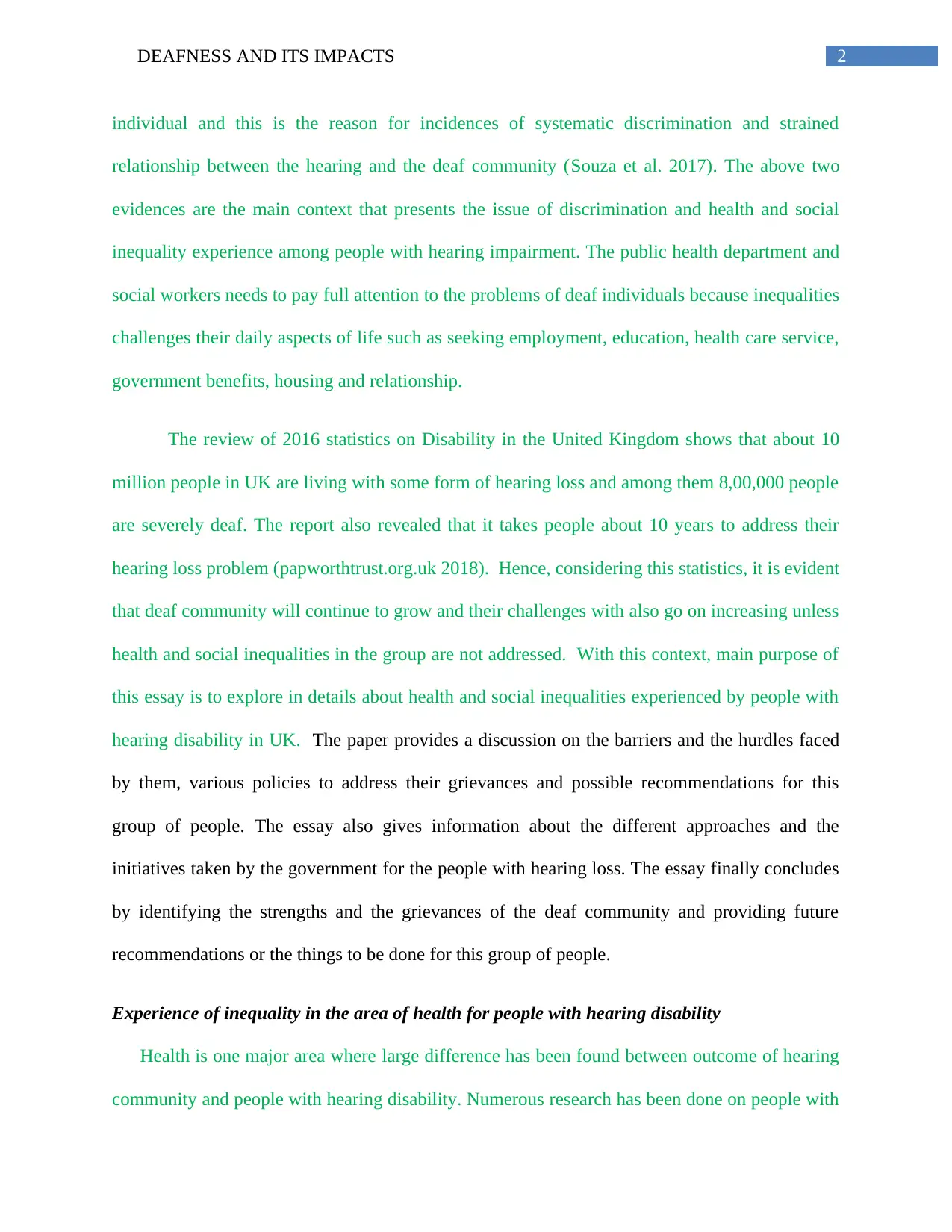
2DEAFNESS AND ITS IMPACTS
individual and this is the reason for incidences of systematic discrimination and strained
relationship between the hearing and the deaf community (Souza et al. 2017). The above two
evidences are the main context that presents the issue of discrimination and health and social
inequality experience among people with hearing impairment. The public health department and
social workers needs to pay full attention to the problems of deaf individuals because inequalities
challenges their daily aspects of life such as seeking employment, education, health care service,
government benefits, housing and relationship.
The review of 2016 statistics on Disability in the United Kingdom shows that about 10
million people in UK are living with some form of hearing loss and among them 8,00,000 people
are severely deaf. The report also revealed that it takes people about 10 years to address their
hearing loss problem (papworthtrust.org.uk 2018). Hence, considering this statistics, it is evident
that deaf community will continue to grow and their challenges with also go on increasing unless
health and social inequalities in the group are not addressed. With this context, main purpose of
this essay is to explore in details about health and social inequalities experienced by people with
hearing disability in UK. The paper provides a discussion on the barriers and the hurdles faced
by them, various policies to address their grievances and possible recommendations for this
group of people. The essay also gives information about the different approaches and the
initiatives taken by the government for the people with hearing loss. The essay finally concludes
by identifying the strengths and the grievances of the deaf community and providing future
recommendations or the things to be done for this group of people.
Experience of inequality in the area of health for people with hearing disability
Health is one major area where large difference has been found between outcome of hearing
community and people with hearing disability. Numerous research has been done on people with
individual and this is the reason for incidences of systematic discrimination and strained
relationship between the hearing and the deaf community (Souza et al. 2017). The above two
evidences are the main context that presents the issue of discrimination and health and social
inequality experience among people with hearing impairment. The public health department and
social workers needs to pay full attention to the problems of deaf individuals because inequalities
challenges their daily aspects of life such as seeking employment, education, health care service,
government benefits, housing and relationship.
The review of 2016 statistics on Disability in the United Kingdom shows that about 10
million people in UK are living with some form of hearing loss and among them 8,00,000 people
are severely deaf. The report also revealed that it takes people about 10 years to address their
hearing loss problem (papworthtrust.org.uk 2018). Hence, considering this statistics, it is evident
that deaf community will continue to grow and their challenges with also go on increasing unless
health and social inequalities in the group are not addressed. With this context, main purpose of
this essay is to explore in details about health and social inequalities experienced by people with
hearing disability in UK. The paper provides a discussion on the barriers and the hurdles faced
by them, various policies to address their grievances and possible recommendations for this
group of people. The essay also gives information about the different approaches and the
initiatives taken by the government for the people with hearing loss. The essay finally concludes
by identifying the strengths and the grievances of the deaf community and providing future
recommendations or the things to be done for this group of people.
Experience of inequality in the area of health for people with hearing disability
Health is one major area where large difference has been found between outcome of hearing
community and people with hearing disability. Numerous research has been done on people with
⊘ This is a preview!⊘
Do you want full access?
Subscribe today to unlock all pages.

Trusted by 1+ million students worldwide
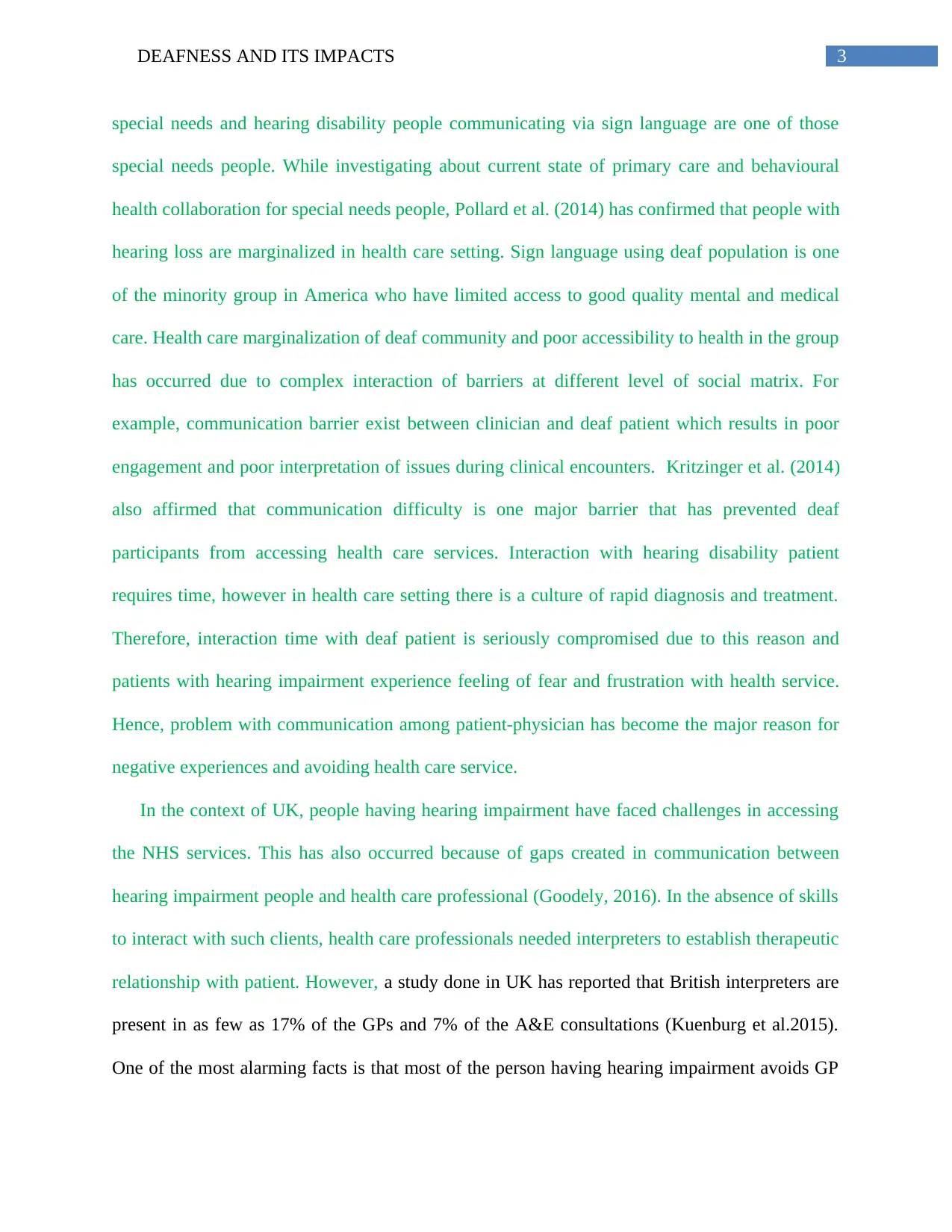
3DEAFNESS AND ITS IMPACTS
special needs and hearing disability people communicating via sign language are one of those
special needs people. While investigating about current state of primary care and behavioural
health collaboration for special needs people, Pollard et al. (2014) has confirmed that people with
hearing loss are marginalized in health care setting. Sign language using deaf population is one
of the minority group in America who have limited access to good quality mental and medical
care. Health care marginalization of deaf community and poor accessibility to health in the group
has occurred due to complex interaction of barriers at different level of social matrix. For
example, communication barrier exist between clinician and deaf patient which results in poor
engagement and poor interpretation of issues during clinical encounters. Kritzinger et al. (2014)
also affirmed that communication difficulty is one major barrier that has prevented deaf
participants from accessing health care services. Interaction with hearing disability patient
requires time, however in health care setting there is a culture of rapid diagnosis and treatment.
Therefore, interaction time with deaf patient is seriously compromised due to this reason and
patients with hearing impairment experience feeling of fear and frustration with health service.
Hence, problem with communication among patient-physician has become the major reason for
negative experiences and avoiding health care service.
In the context of UK, people having hearing impairment have faced challenges in accessing
the NHS services. This has also occurred because of gaps created in communication between
hearing impairment people and health care professional (Goodely, 2016). In the absence of skills
to interact with such clients, health care professionals needed interpreters to establish therapeutic
relationship with patient. However, a study done in UK has reported that British interpreters are
present in as few as 17% of the GPs and 7% of the A&E consultations (Kuenburg et al.2015).
One of the most alarming facts is that most of the person having hearing impairment avoids GP
special needs and hearing disability people communicating via sign language are one of those
special needs people. While investigating about current state of primary care and behavioural
health collaboration for special needs people, Pollard et al. (2014) has confirmed that people with
hearing loss are marginalized in health care setting. Sign language using deaf population is one
of the minority group in America who have limited access to good quality mental and medical
care. Health care marginalization of deaf community and poor accessibility to health in the group
has occurred due to complex interaction of barriers at different level of social matrix. For
example, communication barrier exist between clinician and deaf patient which results in poor
engagement and poor interpretation of issues during clinical encounters. Kritzinger et al. (2014)
also affirmed that communication difficulty is one major barrier that has prevented deaf
participants from accessing health care services. Interaction with hearing disability patient
requires time, however in health care setting there is a culture of rapid diagnosis and treatment.
Therefore, interaction time with deaf patient is seriously compromised due to this reason and
patients with hearing impairment experience feeling of fear and frustration with health service.
Hence, problem with communication among patient-physician has become the major reason for
negative experiences and avoiding health care service.
In the context of UK, people having hearing impairment have faced challenges in accessing
the NHS services. This has also occurred because of gaps created in communication between
hearing impairment people and health care professional (Goodely, 2016). In the absence of skills
to interact with such clients, health care professionals needed interpreters to establish therapeutic
relationship with patient. However, a study done in UK has reported that British interpreters are
present in as few as 17% of the GPs and 7% of the A&E consultations (Kuenburg et al.2015).
One of the most alarming facts is that most of the person having hearing impairment avoids GP
Paraphrase This Document
Need a fresh take? Get an instant paraphrase of this document with our AI Paraphraser
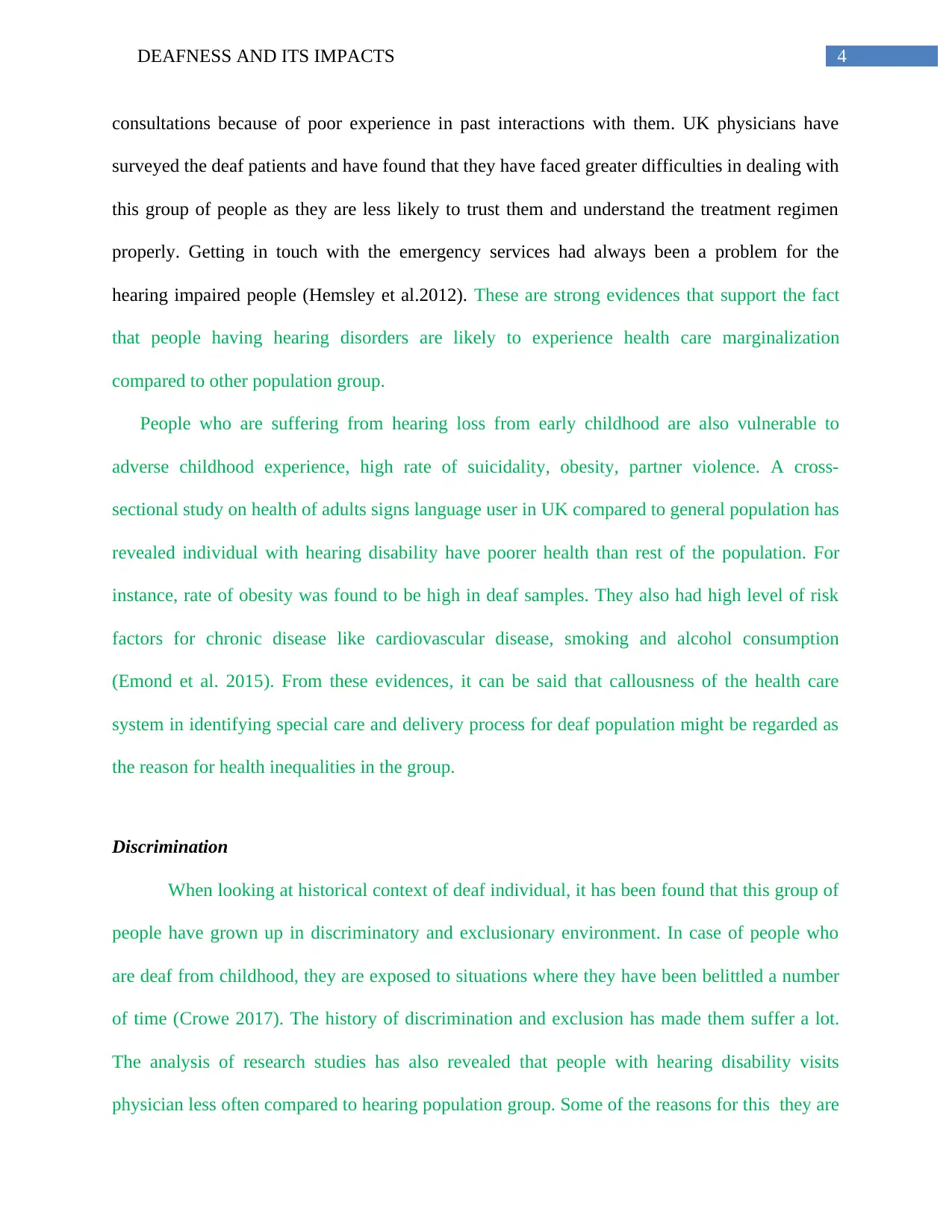
4DEAFNESS AND ITS IMPACTS
consultations because of poor experience in past interactions with them. UK physicians have
surveyed the deaf patients and have found that they have faced greater difficulties in dealing with
this group of people as they are less likely to trust them and understand the treatment regimen
properly. Getting in touch with the emergency services had always been a problem for the
hearing impaired people (Hemsley et al.2012). These are strong evidences that support the fact
that people having hearing disorders are likely to experience health care marginalization
compared to other population group.
People who are suffering from hearing loss from early childhood are also vulnerable to
adverse childhood experience, high rate of suicidality, obesity, partner violence. A cross-
sectional study on health of adults signs language user in UK compared to general population has
revealed individual with hearing disability have poorer health than rest of the population. For
instance, rate of obesity was found to be high in deaf samples. They also had high level of risk
factors for chronic disease like cardiovascular disease, smoking and alcohol consumption
(Emond et al. 2015). From these evidences, it can be said that callousness of the health care
system in identifying special care and delivery process for deaf population might be regarded as
the reason for health inequalities in the group.
Discrimination
When looking at historical context of deaf individual, it has been found that this group of
people have grown up in discriminatory and exclusionary environment. In case of people who
are deaf from childhood, they are exposed to situations where they have been belittled a number
of time (Crowe 2017). The history of discrimination and exclusion has made them suffer a lot.
The analysis of research studies has also revealed that people with hearing disability visits
physician less often compared to hearing population group. Some of the reasons for this they are
consultations because of poor experience in past interactions with them. UK physicians have
surveyed the deaf patients and have found that they have faced greater difficulties in dealing with
this group of people as they are less likely to trust them and understand the treatment regimen
properly. Getting in touch with the emergency services had always been a problem for the
hearing impaired people (Hemsley et al.2012). These are strong evidences that support the fact
that people having hearing disorders are likely to experience health care marginalization
compared to other population group.
People who are suffering from hearing loss from early childhood are also vulnerable to
adverse childhood experience, high rate of suicidality, obesity, partner violence. A cross-
sectional study on health of adults signs language user in UK compared to general population has
revealed individual with hearing disability have poorer health than rest of the population. For
instance, rate of obesity was found to be high in deaf samples. They also had high level of risk
factors for chronic disease like cardiovascular disease, smoking and alcohol consumption
(Emond et al. 2015). From these evidences, it can be said that callousness of the health care
system in identifying special care and delivery process for deaf population might be regarded as
the reason for health inequalities in the group.
Discrimination
When looking at historical context of deaf individual, it has been found that this group of
people have grown up in discriminatory and exclusionary environment. In case of people who
are deaf from childhood, they are exposed to situations where they have been belittled a number
of time (Crowe 2017). The history of discrimination and exclusion has made them suffer a lot.
The analysis of research studies has also revealed that people with hearing disability visits
physician less often compared to hearing population group. Some of the reasons for this they are
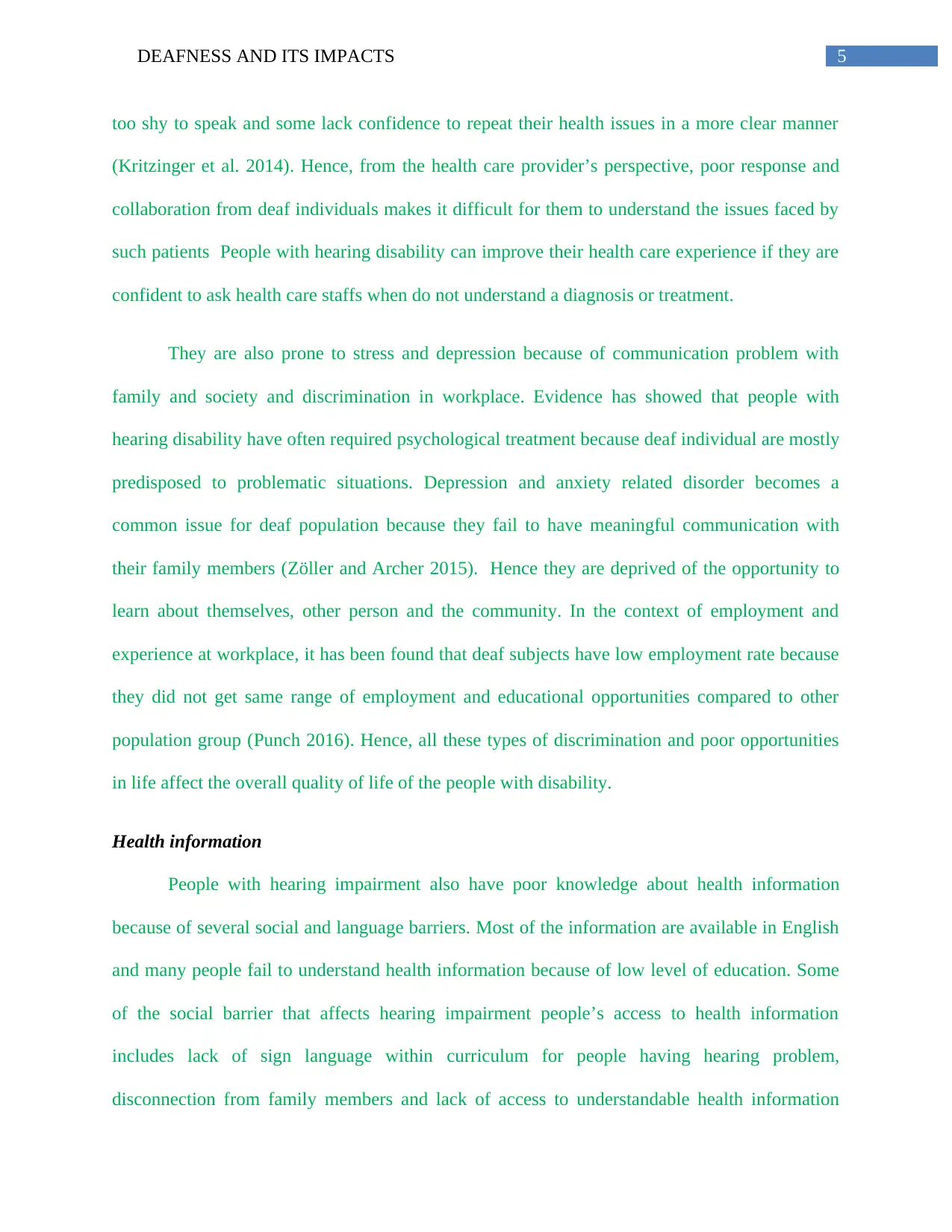
5DEAFNESS AND ITS IMPACTS
too shy to speak and some lack confidence to repeat their health issues in a more clear manner
(Kritzinger et al. 2014). Hence, from the health care provider’s perspective, poor response and
collaboration from deaf individuals makes it difficult for them to understand the issues faced by
such patients People with hearing disability can improve their health care experience if they are
confident to ask health care staffs when do not understand a diagnosis or treatment.
They are also prone to stress and depression because of communication problem with
family and society and discrimination in workplace. Evidence has showed that people with
hearing disability have often required psychological treatment because deaf individual are mostly
predisposed to problematic situations. Depression and anxiety related disorder becomes a
common issue for deaf population because they fail to have meaningful communication with
their family members (Zöller and Archer 2015). Hence they are deprived of the opportunity to
learn about themselves, other person and the community. In the context of employment and
experience at workplace, it has been found that deaf subjects have low employment rate because
they did not get same range of employment and educational opportunities compared to other
population group (Punch 2016). Hence, all these types of discrimination and poor opportunities
in life affect the overall quality of life of the people with disability.
Health information
People with hearing impairment also have poor knowledge about health information
because of several social and language barriers. Most of the information are available in English
and many people fail to understand health information because of low level of education. Some
of the social barrier that affects hearing impairment people’s access to health information
includes lack of sign language within curriculum for people having hearing problem,
disconnection from family members and lack of access to understandable health information
too shy to speak and some lack confidence to repeat their health issues in a more clear manner
(Kritzinger et al. 2014). Hence, from the health care provider’s perspective, poor response and
collaboration from deaf individuals makes it difficult for them to understand the issues faced by
such patients People with hearing disability can improve their health care experience if they are
confident to ask health care staffs when do not understand a diagnosis or treatment.
They are also prone to stress and depression because of communication problem with
family and society and discrimination in workplace. Evidence has showed that people with
hearing disability have often required psychological treatment because deaf individual are mostly
predisposed to problematic situations. Depression and anxiety related disorder becomes a
common issue for deaf population because they fail to have meaningful communication with
their family members (Zöller and Archer 2015). Hence they are deprived of the opportunity to
learn about themselves, other person and the community. In the context of employment and
experience at workplace, it has been found that deaf subjects have low employment rate because
they did not get same range of employment and educational opportunities compared to other
population group (Punch 2016). Hence, all these types of discrimination and poor opportunities
in life affect the overall quality of life of the people with disability.
Health information
People with hearing impairment also have poor knowledge about health information
because of several social and language barriers. Most of the information are available in English
and many people fail to understand health information because of low level of education. Some
of the social barrier that affects hearing impairment people’s access to health information
includes lack of sign language within curriculum for people having hearing problem,
disconnection from family members and lack of access to understandable health information
⊘ This is a preview!⊘
Do you want full access?
Subscribe today to unlock all pages.

Trusted by 1+ million students worldwide

6DEAFNESS AND ITS IMPACTS
(Chininthorn et al. 2016). For example, parents of deaf individuals fail to instruct their child
about basic health risk and dangers. In case of health information available through mass media,
people with hearing disability struggle to understand difficult jargons. Lack of availability of
interpreters in health care context also increases barrier for people with hearing disability in
learning about health information (Olson and Swabey 2017).
The extent of knowledge related to health information among hearing impairment people
can also be understood from the fact that awareness and knowledge regarding HIV and other
sexually transmitted diseases are absent in people with hearing disorders (Li-Korotky 2012).
Most of the awareness campaign that is meant for the normal population is not compatible or
suitable for the people who have hearing disorders, and no initiatives are taken, such that the
contents of the campaign or the program are comprehensive to all (McKee et al. 2015). Hence,
no special attention has been made to make health information more accessible and
comprehensible for special needs people like those with hearing impairment. This is the reason
for lack awareness in areas related to sex education, childbirth, contraception, cancer screening,
laboratory tests and medications.
Social and medical models
In the 18th century 'the medical model' concept came in to light to give a better scientific
understanding of the cause of impairment such as hearing. According to the medical model of
deafness, deafness is regarded as an undesirable trait that should be treated and avoided. In
contrast, the social model of deafness believes that people with hearing disability suffers not
because of physical limitation but because of vulnerabilities present in their surrounding (Lin
2012). Hence, if deaf children are not given appropriate support, they rely on specialized
(Chininthorn et al. 2016). For example, parents of deaf individuals fail to instruct their child
about basic health risk and dangers. In case of health information available through mass media,
people with hearing disability struggle to understand difficult jargons. Lack of availability of
interpreters in health care context also increases barrier for people with hearing disability in
learning about health information (Olson and Swabey 2017).
The extent of knowledge related to health information among hearing impairment people
can also be understood from the fact that awareness and knowledge regarding HIV and other
sexually transmitted diseases are absent in people with hearing disorders (Li-Korotky 2012).
Most of the awareness campaign that is meant for the normal population is not compatible or
suitable for the people who have hearing disorders, and no initiatives are taken, such that the
contents of the campaign or the program are comprehensive to all (McKee et al. 2015). Hence,
no special attention has been made to make health information more accessible and
comprehensible for special needs people like those with hearing impairment. This is the reason
for lack awareness in areas related to sex education, childbirth, contraception, cancer screening,
laboratory tests and medications.
Social and medical models
In the 18th century 'the medical model' concept came in to light to give a better scientific
understanding of the cause of impairment such as hearing. According to the medical model of
deafness, deafness is regarded as an undesirable trait that should be treated and avoided. In
contrast, the social model of deafness believes that people with hearing disability suffers not
because of physical limitation but because of vulnerabilities present in their surrounding (Lin
2012). Hence, if deaf children are not given appropriate support, they rely on specialized
Paraphrase This Document
Need a fresh take? Get an instant paraphrase of this document with our AI Paraphraser
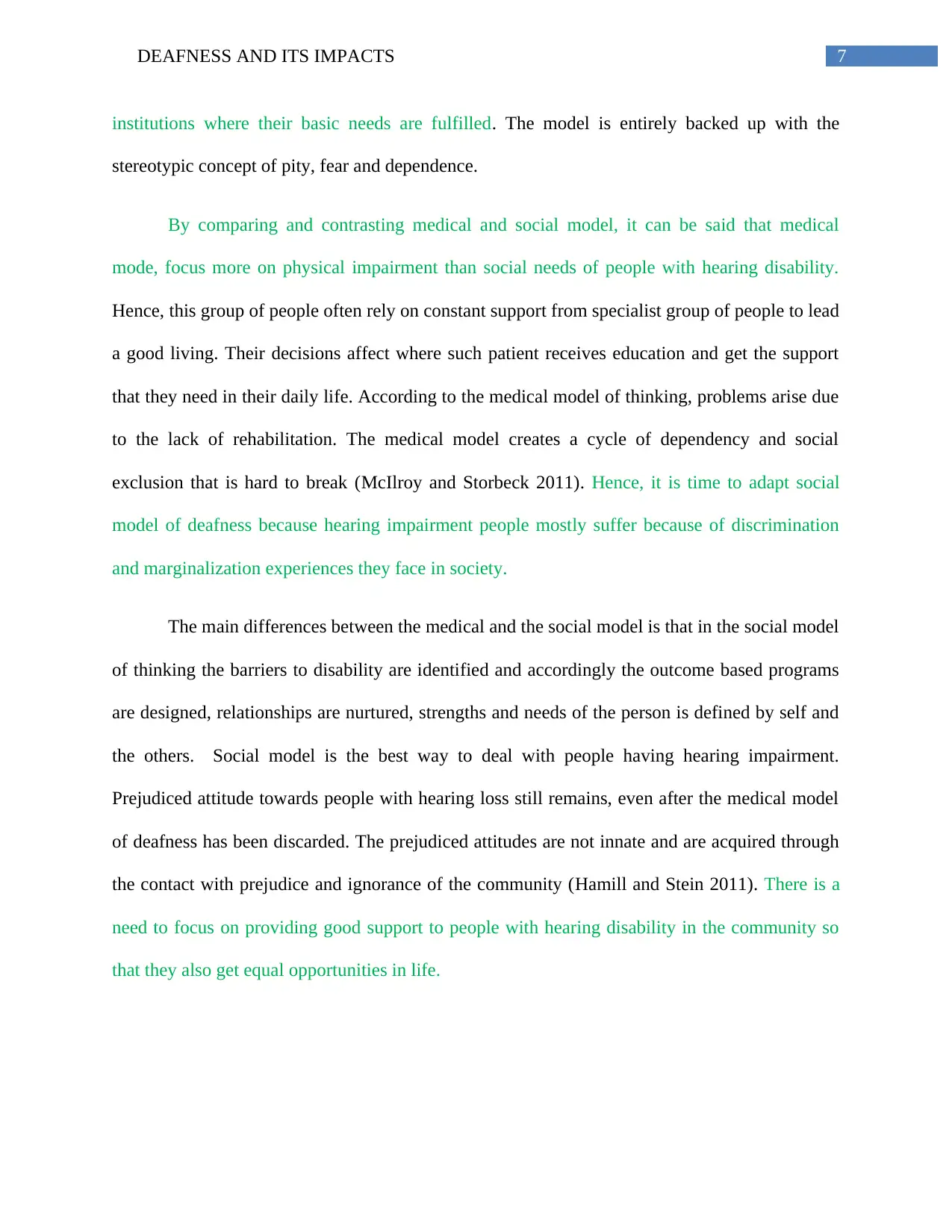
7DEAFNESS AND ITS IMPACTS
institutions where their basic needs are fulfilled. The model is entirely backed up with the
stereotypic concept of pity, fear and dependence.
By comparing and contrasting medical and social model, it can be said that medical
mode, focus more on physical impairment than social needs of people with hearing disability.
Hence, this group of people often rely on constant support from specialist group of people to lead
a good living. Their decisions affect where such patient receives education and get the support
that they need in their daily life. According to the medical model of thinking, problems arise due
to the lack of rehabilitation. The medical model creates a cycle of dependency and social
exclusion that is hard to break (McIlroy and Storbeck 2011). Hence, it is time to adapt social
model of deafness because hearing impairment people mostly suffer because of discrimination
and marginalization experiences they face in society.
The main differences between the medical and the social model is that in the social model
of thinking the barriers to disability are identified and accordingly the outcome based programs
are designed, relationships are nurtured, strengths and needs of the person is defined by self and
the others. Social model is the best way to deal with people having hearing impairment.
Prejudiced attitude towards people with hearing loss still remains, even after the medical model
of deafness has been discarded. The prejudiced attitudes are not innate and are acquired through
the contact with prejudice and ignorance of the community (Hamill and Stein 2011). There is a
need to focus on providing good support to people with hearing disability in the community so
that they also get equal opportunities in life.
institutions where their basic needs are fulfilled. The model is entirely backed up with the
stereotypic concept of pity, fear and dependence.
By comparing and contrasting medical and social model, it can be said that medical
mode, focus more on physical impairment than social needs of people with hearing disability.
Hence, this group of people often rely on constant support from specialist group of people to lead
a good living. Their decisions affect where such patient receives education and get the support
that they need in their daily life. According to the medical model of thinking, problems arise due
to the lack of rehabilitation. The medical model creates a cycle of dependency and social
exclusion that is hard to break (McIlroy and Storbeck 2011). Hence, it is time to adapt social
model of deafness because hearing impairment people mostly suffer because of discrimination
and marginalization experiences they face in society.
The main differences between the medical and the social model is that in the social model
of thinking the barriers to disability are identified and accordingly the outcome based programs
are designed, relationships are nurtured, strengths and needs of the person is defined by self and
the others. Social model is the best way to deal with people having hearing impairment.
Prejudiced attitude towards people with hearing loss still remains, even after the medical model
of deafness has been discarded. The prejudiced attitudes are not innate and are acquired through
the contact with prejudice and ignorance of the community (Hamill and Stein 2011). There is a
need to focus on providing good support to people with hearing disability in the community so
that they also get equal opportunities in life.
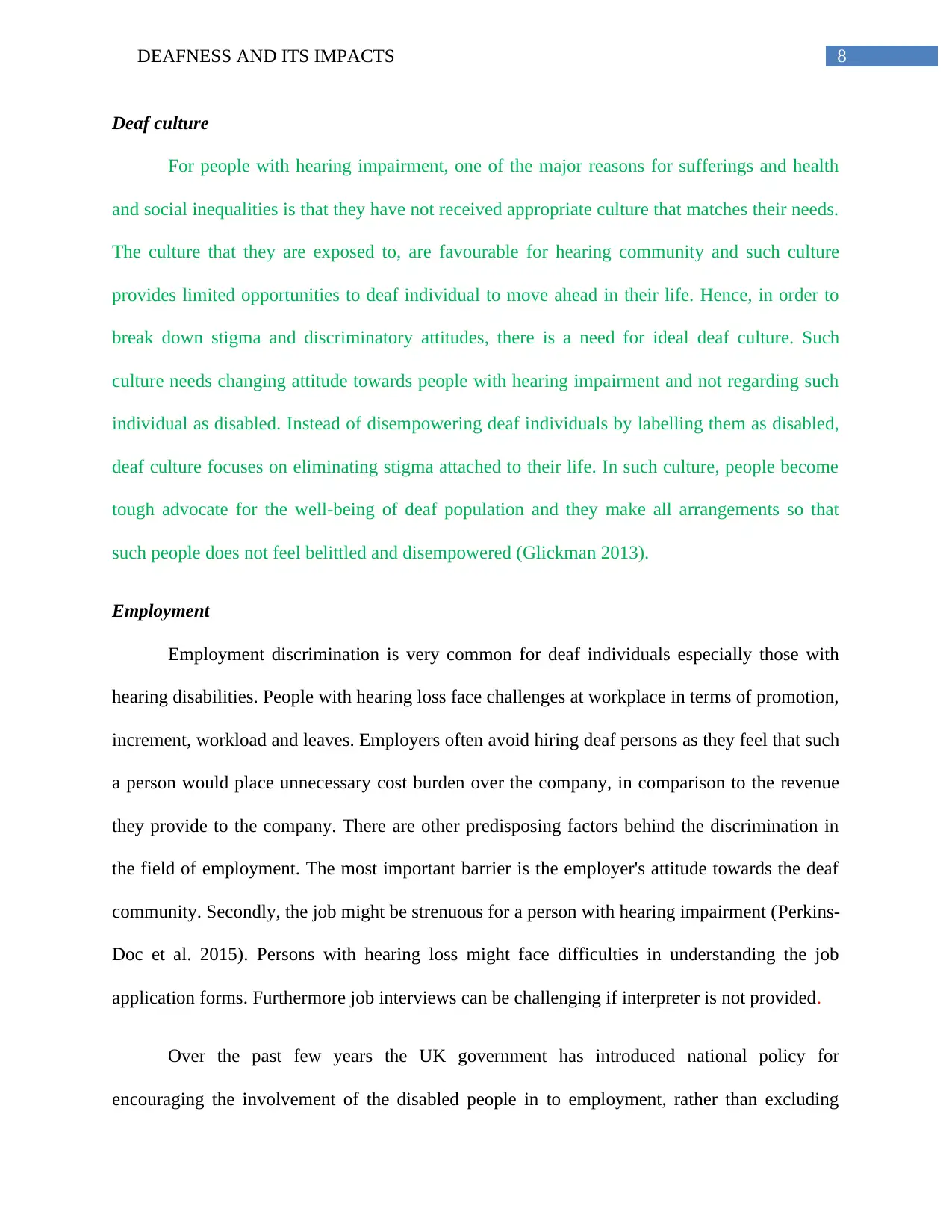
8DEAFNESS AND ITS IMPACTS
Deaf culture
For people with hearing impairment, one of the major reasons for sufferings and health
and social inequalities is that they have not received appropriate culture that matches their needs.
The culture that they are exposed to, are favourable for hearing community and such culture
provides limited opportunities to deaf individual to move ahead in their life. Hence, in order to
break down stigma and discriminatory attitudes, there is a need for ideal deaf culture. Such
culture needs changing attitude towards people with hearing impairment and not regarding such
individual as disabled. Instead of disempowering deaf individuals by labelling them as disabled,
deaf culture focuses on eliminating stigma attached to their life. In such culture, people become
tough advocate for the well-being of deaf population and they make all arrangements so that
such people does not feel belittled and disempowered (Glickman 2013).
Employment
Employment discrimination is very common for deaf individuals especially those with
hearing disabilities. People with hearing loss face challenges at workplace in terms of promotion,
increment, workload and leaves. Employers often avoid hiring deaf persons as they feel that such
a person would place unnecessary cost burden over the company, in comparison to the revenue
they provide to the company. There are other predisposing factors behind the discrimination in
the field of employment. The most important barrier is the employer's attitude towards the deaf
community. Secondly, the job might be strenuous for a person with hearing impairment (Perkins-
Doc et al. 2015). Persons with hearing loss might face difficulties in understanding the job
application forms. Furthermore job interviews can be challenging if interpreter is not provided.
Over the past few years the UK government has introduced national policy for
encouraging the involvement of the disabled people in to employment, rather than excluding
Deaf culture
For people with hearing impairment, one of the major reasons for sufferings and health
and social inequalities is that they have not received appropriate culture that matches their needs.
The culture that they are exposed to, are favourable for hearing community and such culture
provides limited opportunities to deaf individual to move ahead in their life. Hence, in order to
break down stigma and discriminatory attitudes, there is a need for ideal deaf culture. Such
culture needs changing attitude towards people with hearing impairment and not regarding such
individual as disabled. Instead of disempowering deaf individuals by labelling them as disabled,
deaf culture focuses on eliminating stigma attached to their life. In such culture, people become
tough advocate for the well-being of deaf population and they make all arrangements so that
such people does not feel belittled and disempowered (Glickman 2013).
Employment
Employment discrimination is very common for deaf individuals especially those with
hearing disabilities. People with hearing loss face challenges at workplace in terms of promotion,
increment, workload and leaves. Employers often avoid hiring deaf persons as they feel that such
a person would place unnecessary cost burden over the company, in comparison to the revenue
they provide to the company. There are other predisposing factors behind the discrimination in
the field of employment. The most important barrier is the employer's attitude towards the deaf
community. Secondly, the job might be strenuous for a person with hearing impairment (Perkins-
Doc et al. 2015). Persons with hearing loss might face difficulties in understanding the job
application forms. Furthermore job interviews can be challenging if interpreter is not provided.
Over the past few years the UK government has introduced national policy for
encouraging the involvement of the disabled people in to employment, rather than excluding
⊘ This is a preview!⊘
Do you want full access?
Subscribe today to unlock all pages.

Trusted by 1+ million students worldwide
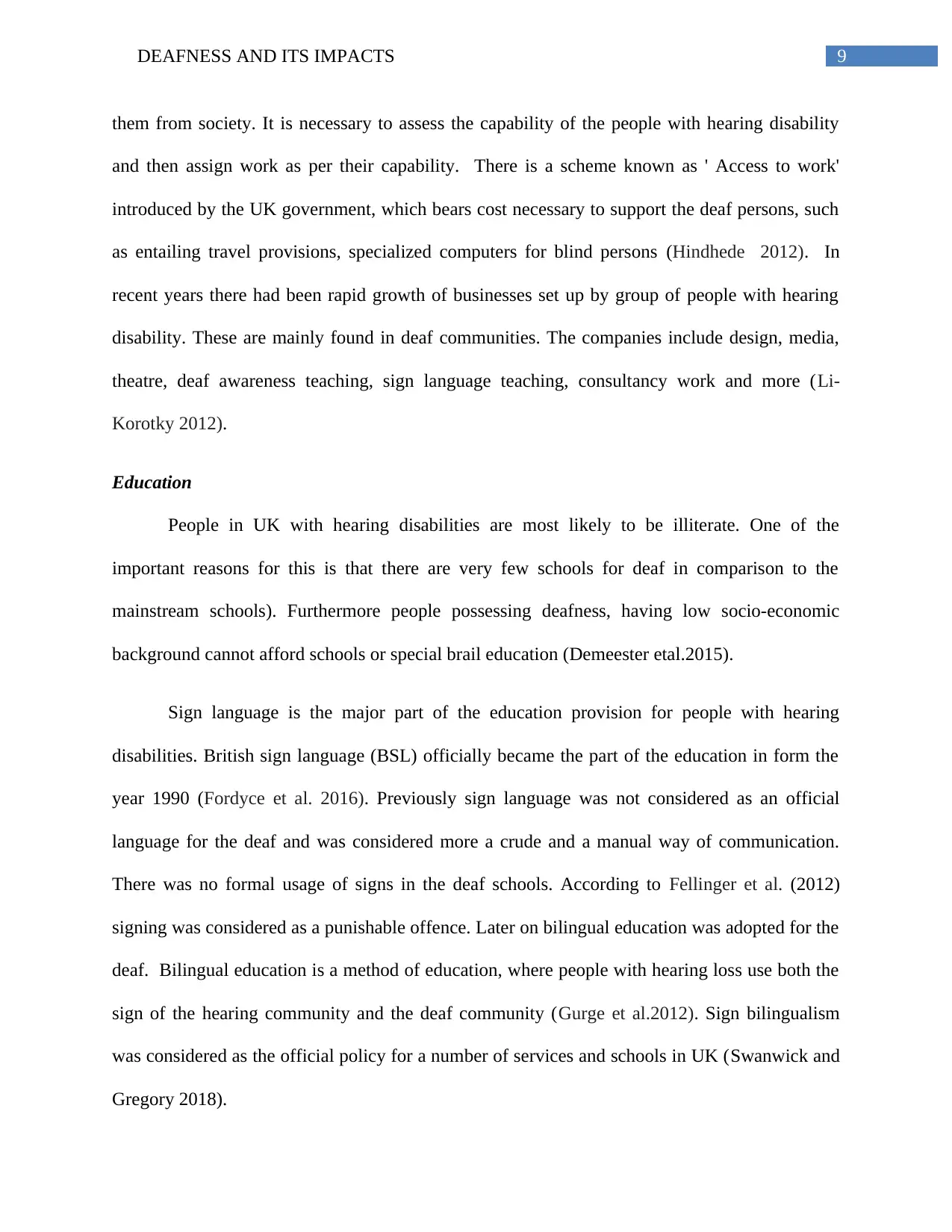
9DEAFNESS AND ITS IMPACTS
them from society. It is necessary to assess the capability of the people with hearing disability
and then assign work as per their capability. There is a scheme known as ' Access to work'
introduced by the UK government, which bears cost necessary to support the deaf persons, such
as entailing travel provisions, specialized computers for blind persons (Hindhede 2012). In
recent years there had been rapid growth of businesses set up by group of people with hearing
disability. These are mainly found in deaf communities. The companies include design, media,
theatre, deaf awareness teaching, sign language teaching, consultancy work and more (Li-
Korotky 2012).
Education
People in UK with hearing disabilities are most likely to be illiterate. One of the
important reasons for this is that there are very few schools for deaf in comparison to the
mainstream schools). Furthermore people possessing deafness, having low socio-economic
background cannot afford schools or special brail education (Demeester etal.2015).
Sign language is the major part of the education provision for people with hearing
disabilities. British sign language (BSL) officially became the part of the education in form the
year 1990 (Fordyce et al. 2016). Previously sign language was not considered as an official
language for the deaf and was considered more a crude and a manual way of communication.
There was no formal usage of signs in the deaf schools. According to Fellinger et al. (2012)
signing was considered as a punishable offence. Later on bilingual education was adopted for the
deaf. Bilingual education is a method of education, where people with hearing loss use both the
sign of the hearing community and the deaf community (Gurge et al.2012). Sign bilingualism
was considered as the official policy for a number of services and schools in UK (Swanwick and
Gregory 2018).
them from society. It is necessary to assess the capability of the people with hearing disability
and then assign work as per their capability. There is a scheme known as ' Access to work'
introduced by the UK government, which bears cost necessary to support the deaf persons, such
as entailing travel provisions, specialized computers for blind persons (Hindhede 2012). In
recent years there had been rapid growth of businesses set up by group of people with hearing
disability. These are mainly found in deaf communities. The companies include design, media,
theatre, deaf awareness teaching, sign language teaching, consultancy work and more (Li-
Korotky 2012).
Education
People in UK with hearing disabilities are most likely to be illiterate. One of the
important reasons for this is that there are very few schools for deaf in comparison to the
mainstream schools). Furthermore people possessing deafness, having low socio-economic
background cannot afford schools or special brail education (Demeester etal.2015).
Sign language is the major part of the education provision for people with hearing
disabilities. British sign language (BSL) officially became the part of the education in form the
year 1990 (Fordyce et al. 2016). Previously sign language was not considered as an official
language for the deaf and was considered more a crude and a manual way of communication.
There was no formal usage of signs in the deaf schools. According to Fellinger et al. (2012)
signing was considered as a punishable offence. Later on bilingual education was adopted for the
deaf. Bilingual education is a method of education, where people with hearing loss use both the
sign of the hearing community and the deaf community (Gurge et al.2012). Sign bilingualism
was considered as the official policy for a number of services and schools in UK (Swanwick and
Gregory 2018).
Paraphrase This Document
Need a fresh take? Get an instant paraphrase of this document with our AI Paraphraser
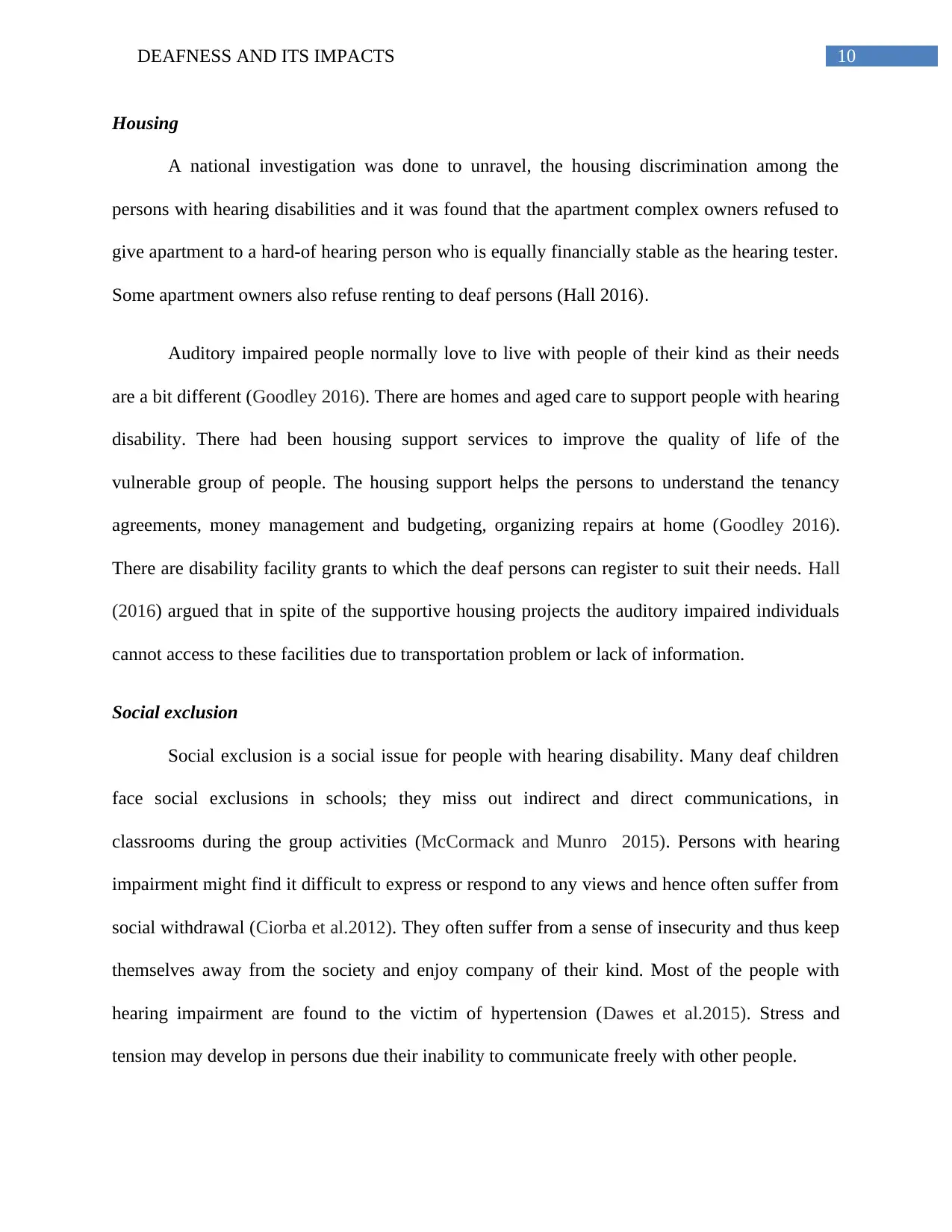
10DEAFNESS AND ITS IMPACTS
Housing
A national investigation was done to unravel, the housing discrimination among the
persons with hearing disabilities and it was found that the apartment complex owners refused to
give apartment to a hard-of hearing person who is equally financially stable as the hearing tester.
Some apartment owners also refuse renting to deaf persons (Hall 2016).
Auditory impaired people normally love to live with people of their kind as their needs
are a bit different (Goodley 2016). There are homes and aged care to support people with hearing
disability. There had been housing support services to improve the quality of life of the
vulnerable group of people. The housing support helps the persons to understand the tenancy
agreements, money management and budgeting, organizing repairs at home (Goodley 2016).
There are disability facility grants to which the deaf persons can register to suit their needs. Hall
(2016) argued that in spite of the supportive housing projects the auditory impaired individuals
cannot access to these facilities due to transportation problem or lack of information.
Social exclusion
Social exclusion is a social issue for people with hearing disability. Many deaf children
face social exclusions in schools; they miss out indirect and direct communications, in
classrooms during the group activities (McCormack and Munro 2015). Persons with hearing
impairment might find it difficult to express or respond to any views and hence often suffer from
social withdrawal (Ciorba et al.2012). They often suffer from a sense of insecurity and thus keep
themselves away from the society and enjoy company of their kind. Most of the people with
hearing impairment are found to the victim of hypertension (Dawes et al.2015). Stress and
tension may develop in persons due their inability to communicate freely with other people.
Housing
A national investigation was done to unravel, the housing discrimination among the
persons with hearing disabilities and it was found that the apartment complex owners refused to
give apartment to a hard-of hearing person who is equally financially stable as the hearing tester.
Some apartment owners also refuse renting to deaf persons (Hall 2016).
Auditory impaired people normally love to live with people of their kind as their needs
are a bit different (Goodley 2016). There are homes and aged care to support people with hearing
disability. There had been housing support services to improve the quality of life of the
vulnerable group of people. The housing support helps the persons to understand the tenancy
agreements, money management and budgeting, organizing repairs at home (Goodley 2016).
There are disability facility grants to which the deaf persons can register to suit their needs. Hall
(2016) argued that in spite of the supportive housing projects the auditory impaired individuals
cannot access to these facilities due to transportation problem or lack of information.
Social exclusion
Social exclusion is a social issue for people with hearing disability. Many deaf children
face social exclusions in schools; they miss out indirect and direct communications, in
classrooms during the group activities (McCormack and Munro 2015). Persons with hearing
impairment might find it difficult to express or respond to any views and hence often suffer from
social withdrawal (Ciorba et al.2012). They often suffer from a sense of insecurity and thus keep
themselves away from the society and enjoy company of their kind. Most of the people with
hearing impairment are found to the victim of hypertension (Dawes et al.2015). Stress and
tension may develop in persons due their inability to communicate freely with other people.
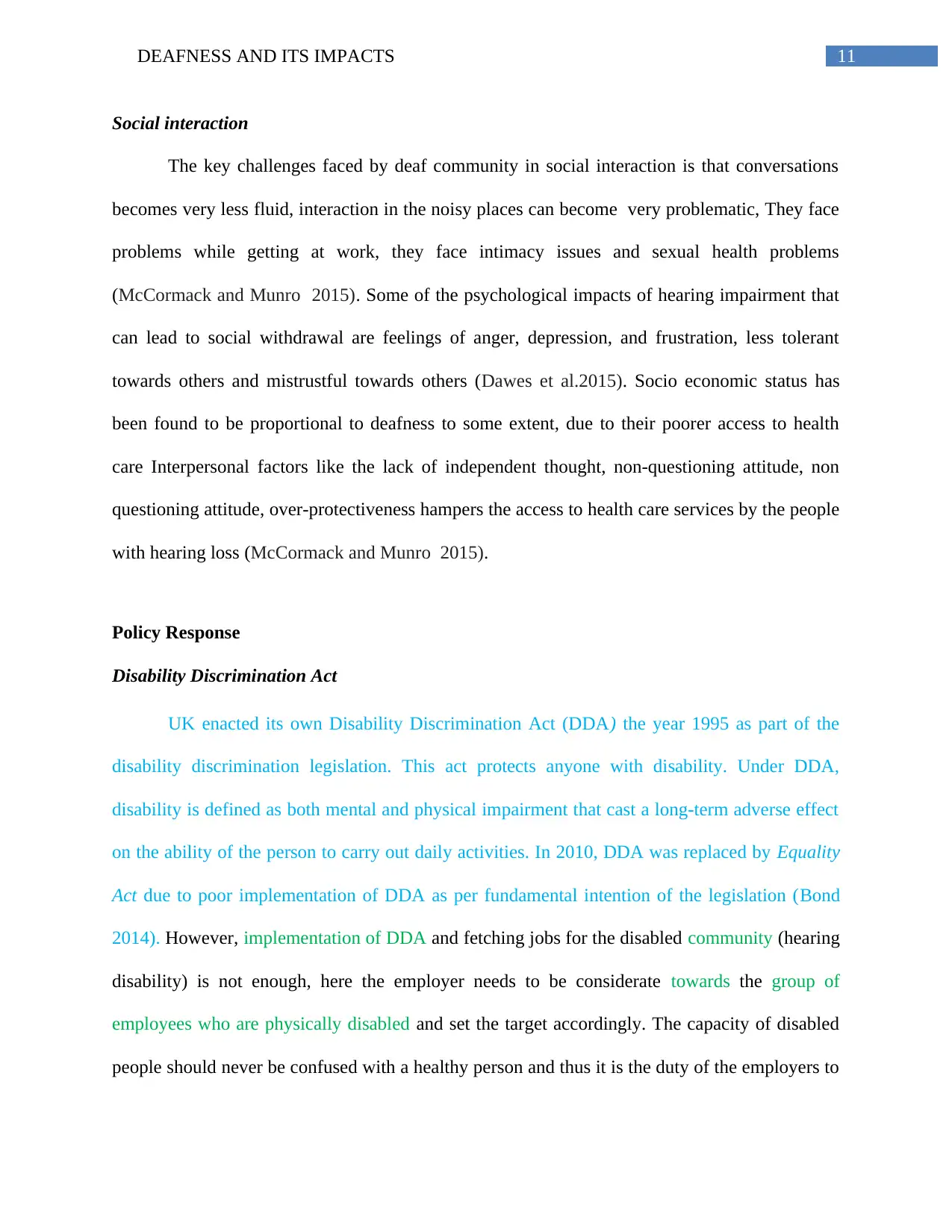
11DEAFNESS AND ITS IMPACTS
Social interaction
The key challenges faced by deaf community in social interaction is that conversations
becomes very less fluid, interaction in the noisy places can become very problematic, They face
problems while getting at work, they face intimacy issues and sexual health problems
(McCormack and Munro 2015). Some of the psychological impacts of hearing impairment that
can lead to social withdrawal are feelings of anger, depression, and frustration, less tolerant
towards others and mistrustful towards others (Dawes et al.2015). Socio economic status has
been found to be proportional to deafness to some extent, due to their poorer access to health
care Interpersonal factors like the lack of independent thought, non-questioning attitude, non
questioning attitude, over-protectiveness hampers the access to health care services by the people
with hearing loss (McCormack and Munro 2015).
Policy Response
Disability Discrimination Act
UK enacted its own Disability Discrimination Act (DDA) the year 1995 as part of the
disability discrimination legislation. This act protects anyone with disability. Under DDA,
disability is defined as both mental and physical impairment that cast a long-term adverse effect
on the ability of the person to carry out daily activities. In 2010, DDA was replaced by Equality
Act due to poor implementation of DDA as per fundamental intention of the legislation (Bond
2014). However, implementation of DDA and fetching jobs for the disabled community (hearing
disability) is not enough, here the employer needs to be considerate towards the group of
employees who are physically disabled and set the target accordingly. The capacity of disabled
people should never be confused with a healthy person and thus it is the duty of the employers to
Social interaction
The key challenges faced by deaf community in social interaction is that conversations
becomes very less fluid, interaction in the noisy places can become very problematic, They face
problems while getting at work, they face intimacy issues and sexual health problems
(McCormack and Munro 2015). Some of the psychological impacts of hearing impairment that
can lead to social withdrawal are feelings of anger, depression, and frustration, less tolerant
towards others and mistrustful towards others (Dawes et al.2015). Socio economic status has
been found to be proportional to deafness to some extent, due to their poorer access to health
care Interpersonal factors like the lack of independent thought, non-questioning attitude, non
questioning attitude, over-protectiveness hampers the access to health care services by the people
with hearing loss (McCormack and Munro 2015).
Policy Response
Disability Discrimination Act
UK enacted its own Disability Discrimination Act (DDA) the year 1995 as part of the
disability discrimination legislation. This act protects anyone with disability. Under DDA,
disability is defined as both mental and physical impairment that cast a long-term adverse effect
on the ability of the person to carry out daily activities. In 2010, DDA was replaced by Equality
Act due to poor implementation of DDA as per fundamental intention of the legislation (Bond
2014). However, implementation of DDA and fetching jobs for the disabled community (hearing
disability) is not enough, here the employer needs to be considerate towards the group of
employees who are physically disabled and set the target accordingly. The capacity of disabled
people should never be confused with a healthy person and thus it is the duty of the employers to
⊘ This is a preview!⊘
Do you want full access?
Subscribe today to unlock all pages.

Trusted by 1+ million students worldwide
1 out of 24
Related Documents
Your All-in-One AI-Powered Toolkit for Academic Success.
+13062052269
info@desklib.com
Available 24*7 on WhatsApp / Email
![[object Object]](/_next/static/media/star-bottom.7253800d.svg)
Unlock your academic potential
Copyright © 2020–2025 A2Z Services. All Rights Reserved. Developed and managed by ZUCOL.





